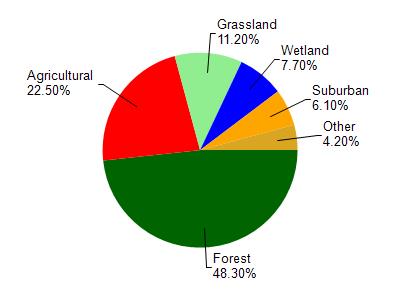Sauk
Yes
Yes
No
Fish and Aquatic Life
Overview
Hulbert Creek is a tributary to the Wisconsin River at Wisconsin Dells. It is considered trout
waters for four miles of its length, 2.8 miles of the upper reaches are a Class I trout stream and
an exceptional resource water (ERW). The downstream reach is affected by the intense urban
development of Wisconsin Dells. Other problems on the creek include agricultural nonpoint
sources of pollution including the destruction of spring heads due to cattle, beaver dams and
hydrologic modification. The stream has little in-stream habitat, which is thought to be
limiting the stream's fishery potential. A rare aquatic species has been found in this creek in
past surveys. The WDNR owns over 300 acres along the corridor of Hulburt Creek that is
open to the public.
Ripp, Coreen, Koperski, Cindy and Folstad, Jason. 2002. The State of the Lower Wisconsin River Basin.
PUBL WT-559-2002. Wisconsin Department of Natural Resources, Madison, WI.
Date 2002
Author Cynthia Koperski
Historical Description
Hulbert Creek is a tributary to the Wisconsin River at Wisconsin Dells. It is considered
trout waters for four miles of its length, 2.8 miles of this Class I trout stream (WDNR,
1980). The downstream reach is affected by the intense urban development of
Wisconsin Dells. A study of historic and recent nitrale-N levels in the stream have sho
those levels have remained unchanged over time (Mason, 1990).
Date 1994
Author Surface Water Inventory Of Wisconsin
Impaired Waters
Hulbert Creek (1298500), from the mouth to CTH H, was assessed during the 2016 listing cycle; total phosphorus sample data exceed 2016 WisCALM listing criteria for the Fish and Aquatic Life use, however, available biological data do not indicate impairment (i.e. no macroinvertebrate or fish Index of Biotic Integrity (IBI) scored in the "poor" condition category).
Date 2015
Author Aaron Larson
Condition
Wisconsin has over 84,000 miles of streams, 15,000 lakes and milllions of acres of wetlands. Assessing the condition of this vast amount of water is challenging. The state's water monitoring program uses a media-based, cross-program approach to analyze water condition. An updated monitoring strategy (2015-2020) is now available. Compliance with Clean Water Act fishable, swimmable standards are located in the Executive Summary of Water Condition in 2018. See also the 'monitoring and projects' tab.
Reports
Management Goals
Wisconsin's Water Quality Standards provide qualitative and quantitative goals for waters that are protective of Fishable, Swimmable conditions [Learn more]. Waters that do not meet water quality standards are considered impaired and restoration actions are planned and carried out until the water is once again fishable and swimmable
Management goals can include creation or implementation of a Total Maximum Daily Load analysis, a Nine Key Element Plan, or other restoration work, education and outreach and more. If specific recommendations exist for this water, they will be displayed below online.
Monitoring
Monitoring the condition of a river, stream, or lake includes gathering physical, chemical, biological, and habitat data. Comprehensive studies often gather all these parameters in great detail, while lighter assessment events will involve sampling physical, chemical and biological data such as macroinvertebrates. Aquatic macroinvertebrates and fish communities integrate watershed or catchment condition, providing great insight into overall ecosystem health. Chemical and habitat parameters tell researchers more about human induced problems including contaminated runoff, point source dischargers, or habitat issues that foster or limit the potential of aquatic communities to thrive in a given area. Wisconsin's Water Monitoring Strategy was recenty updated.
Grants and Management Projects
Monitoring Projects
| WBIC | Official Waterbody Name | Station ID | Station Name | Earliest Fieldwork Date | Latest Fieldwork Date | View Station | View Data |
|---|
| 1298500 | Hulburt Creek | 10040527 | Hulburt Creek at CTH H (Site 5) | 5/3/1997 | 6/5/1997 | Map | Data |
| 1298500 | Hulburt Creek | 10008568 | Hulburt Creek-60m Upstream Cty Hwy H | 5/21/2007 | 1/1/2015 | Map | Data |
|

Watershed Characteristics
Hulburt Creek is located in the Dell Creek watershed which is 133.73 mi². Land use in the watershed is primarily forest (48.30%), agricultural (22.50%) and a mix of grassland (11.20%) and other uses (18.00%). This watershed has 231.97 stream miles, 193.10 lake acres and 4,715.88 wetland acres.
Nonpoint Source Characteristics
This watershed is ranked High for runoff impacts on streams, Medium for runoff impacts on lakes and High for runoff impacts on groundwater and therefore has an overall rank of High. This value can be used in ranking the watershed or individual waterbodies for grant funding under state and county programs.However, all waters are affected by diffuse pollutant sources regardless of initial water quality. Applications for specific runoff projects under state or county grant programs may be pursued. For more information, go to surface water program grants.